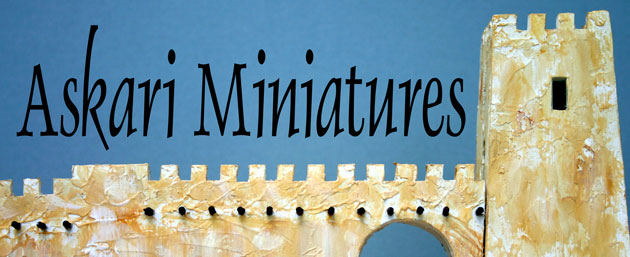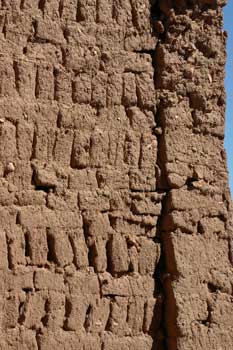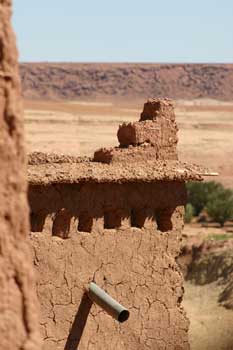Ait Ben Haddou is a World Heritage site, one of many Berber fortified villages to be found in the High Atlas.
It is much photographed and used in movies (but don’t ask which one(s)–while that comment is often repeated, I’ve not seen any specifics. ABH is a classic Berber ksar, or fortified village. It consists of several fine kasbahs, (fortified houses) and blocks of less grand dwellings. The buildings are more decorated than most but otherwise quite typical.
At right, you can see one of the larger kasbahs with four towers. According to Islam, a man may have up to four wives, but he must treat each one equally. So the wealthy (and perhaps foolish) man with four wives installs one in each of the four towers along with her children and servants. In other photos, you will see kasbahs with three or two towers.
|
The buildings are made from natural materials readily available. As a result, they blend in with the surroundings very well. The lower levels are made of “rammed earth.” Two boards held together with ropes are set atop the wall (or the ground) and a mixture of mud and straw is rammed into the form. This dries and the form is moved to the next position. It give a look to the wall something like giant Legos. Stand-alone walls are made in this way as well as the lower stories of buildings. Higher up, mud bricks are used. These are the same materials as the rammed earth walls, but the mud is set into forms and dried in the sun. They are then usually stacked as we would expect to see fired bricks but without mortar as far as I can tell. In the photo at right, they are stacked to fill the space in a somewhat unusual way. |
|
|
The roof is made of layers of palm wood, split and unsplit bamboo and palm branches, covered with dirt, as shown at left. The roof overhangs the walls and offers some protection from the (infrequent) rain. The pipe is a way of draining water out of the building. The whole is covered with a plaster called pise, which, as far as I can tell, isn’t a whole lot different material from the earth but is rather finer and does form a smooth surface. In the cities today, it can be colored and is applied much like plaster with trowels. The negative relief decorations are just places where the plaster has not covered the bricks. These are quite elaborate at Ait Ben Haddou. Buildings of this type require constant upkeep and where this is lacking they soon fall into disrepair. |
|
 |
At left is the beginning of a kasbah. The towers are up to five stories high, the walls four. Hard to believe mud bricks could be stacked this high, but they are. They get stability from the fact that they are angled inwards, forming a slight pyramidal shape, and from the thickness of the walls. The floors and ceilings between the stories are made from a few palm logs overlaid with split bamboo in several layers and packed with more of the dirt. In the left background is a three-story tower for comparison. |
 |
Here’s the whole village underway. The large kasbah is at the lower right. I decided that the connecting walls were too long. Cardboard shapes mark the approximate size of housing blocks, several of which can be seen under construction. A second, smaller kasbah is on the right. The hillside is mocked up with layers of styrofoam insulation. The relationship between the buildings and the layers of the hillside is fluid at this point. The extent of the village, the height of the hill and of the buildings, and the playability of the whole are all things that need to be kept in balance. The unusual thing about this ksar is that the kasbahs are on the bottom of the hill instead of at the top. |
 |
With the kasbahs now glued together, it was time to work on the hillside. The village is on a mostly mud and clay hill, partly dug into the hillside. The white styrofoam isn’t as nice to work with as the pink or blue basement insulation styrofoam, so I tried again with 1 1/2″ thick pink stuff. Both the pink and blue varieties come in 2’x8′ sheets. At this stage I began to be concerned about how I would transport it, which constrained dimensions. |
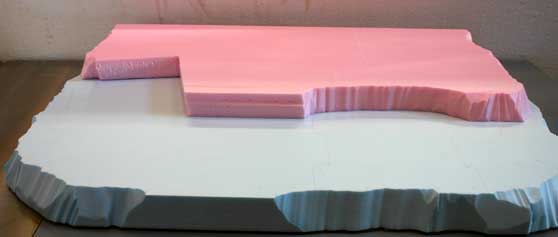 |
After looking around a bit I finally found a sturdy cardboard box with interior dimensions of 24″x33″x6″–almost perfect. The pink styrofoam comes with a beveled edge (see photo above) so I could only get 22″ of width out of it–depth as far as the model is concerned. So I tried 2″ thick blue styrofoam for the bottom layer. Depth is the most critical dimension since one needs depth to get enough layers one behind the other. This was my fourth try to get a base piece that was solid and flat. The blue piece is glued to 1/8″ pegboard with Liquid Nails…and carefully weighted to keep it flat while drying. |
 |
The first two layers are glued together and the buildings are put in their places. The kasbah on the left is built into the hillside; that on the right has the hillside behind it cleared out to form a sort of dry moat. An extra piece of pink stuff can be fashioned to provide a ramp to the second level and some of the smaller buildings can be fit around the main ones. The buildings on the second level are actually blocks of smaller houses built right next to each other. |
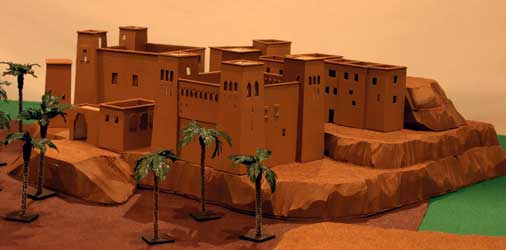 |
With the buildings and terrain painted the mid-brown of the original, here is the ksar as seen at Genghis Con 06 on February 18, 2006. The next steps are to work on the palms and cultivated fields and add more buildings and connecting walls as in the original. |
 |
Phase II: More buildings added to “fill out” the terrain and make it look more like a crowded village. Note the ruined gatehouse–for some reason, the French tend to attack it, so I thought I’d build a ruined version. The original is standing in for something else that needs to be built on the right side of the four-tower kasbah. |
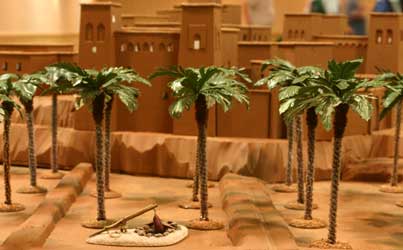 |
The Palmerie: The final task (for now…) was was to make the palm grove. Plants are cultivated in flat spaces separated by earthen “dikes,” the whole area being flooded on a precise timetable. I cut 1/4″ pegboard for the bottom and made the dikes from foam and plaster. I laid magnetic sheeting on top. The palms are mounted on 1″ washers. The weight of the washers and the magnets make them resistant to being knocked over during a game but allow them to be moved around to accommodate troop deployments. The dikes do provide cover for kneeling or lying troops. |
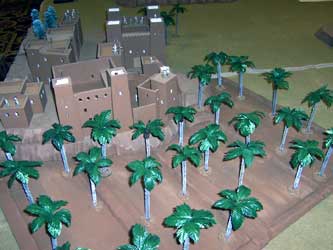 |
An overall view of the palm grove. The pegboard was cut to fit around the side of the hill and made in two parts for easy transport. (Photo courtesy Jeff Baumal at Historicon 06) |
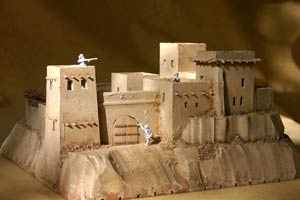 |
OK, this has nothing to do with the Berber village, but it is my latest project…an Afghan Hill Fort |
